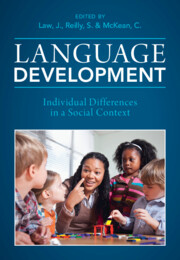Book contents
- Language Development
- Language Development
- Copyright page
- Contents
- Figures
- Tables
- Contributors
- A Tribute to Our Friend, Colleague and Fellow Editor, Professor James Law
- Introduction
- Part One Factors Influencing Language Development
- Part Two Continuity and Change
- Part Three Impact, Intervention and Equity
- 15 Communication, Participation and Cohort Studies
- 16 Capturing the Voice of Parents and Children
- 17 Oral Language Skills as a Foundation for Learning to Learn
- 18 The Economic Impact of Low Language Ability in Childhood
- 19 A Review of Interventions to Promote Language Development in Early Childhood
- 20 Interventions to Promote Language Development in Typical and Atypical Populations
- 21 The Effect of Kindergarten Instructional Policies on Reading and Math Achievement Gaps
- 22 Educational Interventions Targeting Language Development
- 23 Equity and Access to Services for Children with Language Difficulties
- Index
- References
21 - The Effect of Kindergarten Instructional Policies on Reading and Math Achievement Gaps
from Part Three - Impact, Intervention and Equity
Published online by Cambridge University Press: 11 August 2022
- Language Development
- Language Development
- Copyright page
- Contents
- Figures
- Tables
- Contributors
- A Tribute to Our Friend, Colleague and Fellow Editor, Professor James Law
- Introduction
- Part One Factors Influencing Language Development
- Part Two Continuity and Change
- Part Three Impact, Intervention and Equity
- 15 Communication, Participation and Cohort Studies
- 16 Capturing the Voice of Parents and Children
- 17 Oral Language Skills as a Foundation for Learning to Learn
- 18 The Economic Impact of Low Language Ability in Childhood
- 19 A Review of Interventions to Promote Language Development in Early Childhood
- 20 Interventions to Promote Language Development in Typical and Atypical Populations
- 21 The Effect of Kindergarten Instructional Policies on Reading and Math Achievement Gaps
- 22 Educational Interventions Targeting Language Development
- 23 Equity and Access to Services for Children with Language Difficulties
- Index
- References
Summary
This chapter provides new evidence on the effects of kindergarten instructional policies on reading and math achievement gaps between students from low and high socio-economic status (SES) families. Children enrolled in full-day kindergarten see greater gains in reading and math between fall and spring kindergarten than their counterparts who were enrolled half-day. There are also gains associated with instruction time and ability grouping within kindergarten programs. However, these effects are not significantly different for children from low vs high SES families. These results indicate that kindergarten instructional policies do matter for kindergarten learning but also suggest that if such policies are to play a role in reducing SES gaps, it would be through differentially assigning children from low SES families to them rather than through differential gains by SES.
Keywords
- Type
- Chapter
- Information
- Language DevelopmentIndividual Differences in a Social Context, pp. 495 - 518Publisher: Cambridge University PressPrint publication year: 2022



